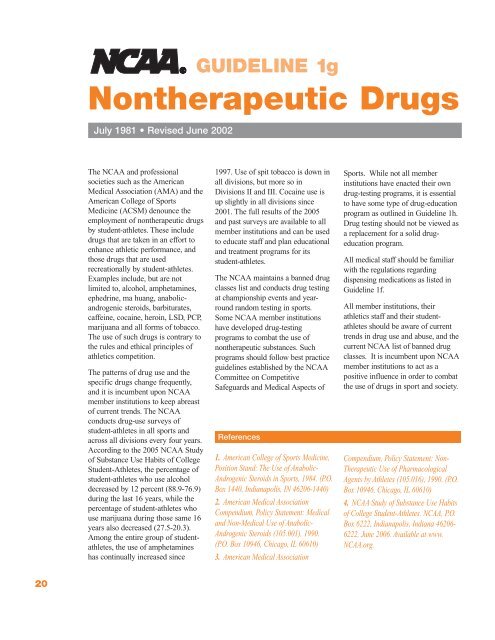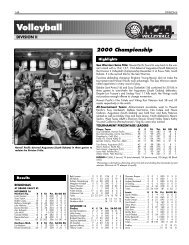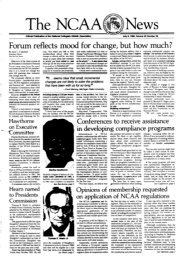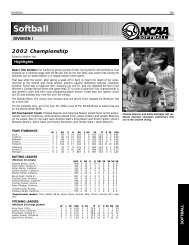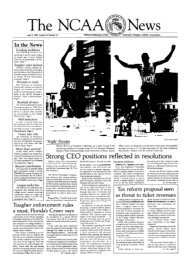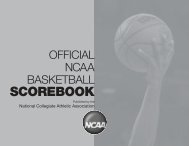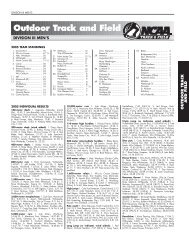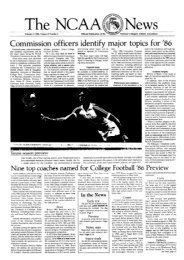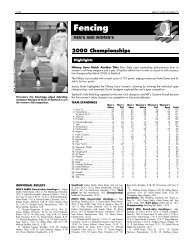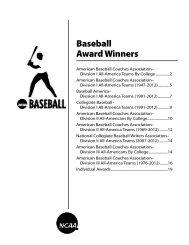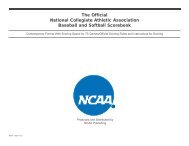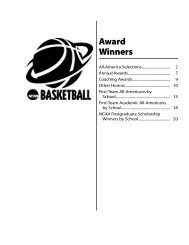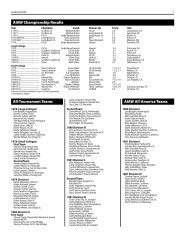Sports Medicine Handbook - NCAA
Sports Medicine Handbook - NCAA
Sports Medicine Handbook - NCAA
You also want an ePaper? Increase the reach of your titles
YUMPU automatically turns print PDFs into web optimized ePapers that Google loves.
20<br />
Nontherapeutic Drugs<br />
July 1981 • Revised June 2002<br />
The <strong>NCAA</strong> and professional<br />
societies such as the American<br />
Medical Association (AMA) and the<br />
American College of <strong>Sports</strong><br />
<strong>Medicine</strong> (ACSM) denounce the<br />
employment of nontherapeutic drugs<br />
by student-athletes. These include<br />
drugs that are taken in an effort to<br />
enhance athletic performance, and<br />
those drugs that are used<br />
recreationally by student-athletes.<br />
Examples include, but are not<br />
limited to, alcohol, amphetamines,<br />
ephedrine, ma huang, anabolicandrogenic<br />
steroids, barbiturates,<br />
caffeine, cocaine, heroin, LSD, PCP,<br />
marijuana and all forms of tobacco.<br />
The use of such drugs is contrary to<br />
the rules and ethical principles of<br />
athletics competition.<br />
The patterns of drug use and the<br />
specific drugs change frequently,<br />
and it is incumbent upon <strong>NCAA</strong><br />
member institutions to keep abreast<br />
of current trends. The <strong>NCAA</strong><br />
conducts drug-use surveys of<br />
student-athletes in all sports and<br />
across all divisions every four years.<br />
According to the 2005 <strong>NCAA</strong> Study<br />
of Substance Use Habits of College<br />
Student-Athletes, the percentage of<br />
student-athletes who use alcohol<br />
decreased by 12 percent (88.9-76.9)<br />
during the last 16 years, while the<br />
percentage of student-athletes who<br />
use marijuana during those same 16<br />
years also decreased (27.5-20.3).<br />
Among the entire group of studentathletes,<br />
the use of amphetamines<br />
has continually increased since<br />
GUIDELINE 1g<br />
1997. Use of spit tobacco is down in<br />
all divisions, but more so in<br />
Divisions II and III. Cocaine use is<br />
up slightly in all divisions since<br />
2001. The full results of the 2005<br />
and past surveys are available to all<br />
member institutions and can be used<br />
to educate staff and plan educational<br />
and treatment programs for its<br />
student-athletes.<br />
The <strong>NCAA</strong> maintains a banned drug<br />
classes list and conducts drug testing<br />
at championship events and yearround<br />
random testing in sports.<br />
Some <strong>NCAA</strong> member institutions<br />
have developed drug-testing<br />
programs to combat the use of<br />
nontherapeutic substances. Such<br />
programs should follow best practice<br />
guidelines established by the <strong>NCAA</strong><br />
Com mittee on Competitive<br />
Safeguards and Medical Aspects of<br />
References<br />
1. American College of <strong>Sports</strong> <strong>Medicine</strong>,<br />
Position Stand: The Use of Anabolic-<br />
Androgenic Steroids in <strong>Sports</strong>, 1984. (P.O.<br />
Box 1440, Indianapolis, IN 46206-1440)<br />
2. American Medical Association<br />
Compendium, Policy Statement: Medical<br />
and Non-Medical Use of Anabolic-<br />
Androgenic Steroids (105.001), 1990.<br />
(P.O. Box 10946, Chicago, IL 60610)<br />
3. American Medical Association<br />
<strong>Sports</strong>. While not all member<br />
institutions have enacted their own<br />
drug-testing programs, it is essential<br />
to have some type of drug-education<br />
program as outlined in Guideline 1h.<br />
Drug testing should not be viewed as<br />
a replacement for a solid drugeducation<br />
program.<br />
All medical staff should be familiar<br />
with the regulations regarding<br />
dispensing medications as listed in<br />
Guideline 1f.<br />
All member institutions, their<br />
athletics staff and their studentathletes<br />
should be aware of current<br />
trends in drug use and abuse, and the<br />
current <strong>NCAA</strong> list of banned drug<br />
classes. It is incumbent upon <strong>NCAA</strong><br />
member institutions to act as a<br />
positive influence in order to combat<br />
the use of drugs in sport and society.<br />
Compendium, Policy Statement: Non-<br />
Therapeutic Use of Pharmacological<br />
Agents by Athletes (105.016), 1990. (P.O.<br />
Box 10946, Chicago, IL 60610)<br />
4. <strong>NCAA</strong> Study of Substance Use Habits<br />
of College Student-Athletes. <strong>NCAA</strong>, P.O.<br />
Box 6222, Indianapolis, Indiana 46206-<br />
6222, June 2006. Available at www.<br />
<strong>NCAA</strong>.org.


